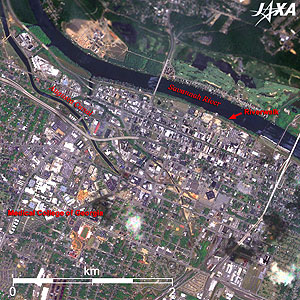Seen from Space 2008
Augusta: The Garden City of Georgia, the United States
Many cities such as Philadelphia and Washington, D.C. in the eastern United States are located along a geographical feature known as a fall line. This fall line forms the boundary between the Piedmont Hills in the east Appalachian Mountains and the coastal plain across which rivers from the upland region drop to the plain as falls or rapids, and cities located there are called fall line cities. Augusta is a fall line city located in the middle of the stream of Savannah River which flows from the upper left to the lower right in the figure. Augusta has developed as one of the world's largest cotton markets and is now the second largest city (with a population of 190,000) in Georgia after the state capital Atlanta (with a population of 420,000) located about 240km to the west. Augusta Canal running parallel to the Savannah River was built for water resources in 1845. Augusta is now famous for the Masters Tournament. The Augusta National Golf Club is located about 5km northwest of Augusta. Unlike the other three major tournaments that change courses every year, the Masters is held at the same venue in early April. The tournament in 2008 took place from April 10 to 13. Daniel Field, located about 7km west of the city, is a private airport mainly used by golfers and patrons of the Masters Tournament. Augusta Regional Airport in the city's south side is the main airport (not visible in the figure).
Augusta is also famous for being a very tough course. Large contours, fast greens, and frequently changing wind direction make top players struggle to overcome the course. Holes by the water such as Hogan Bridge (12th), Nelson Bridge (11th), and Sarazen Bridge (15th) are particularly difficult. The 11th, 12th, and 13th holes at Augusta were termed "Amen Corner" because of the critical play on the final day in the 1958 Masters. A sportswriter gave this name in an article in a 1958 issue of Sports Illustrated, and this is the 50th year of "Amen Corner." His inspiration for the name came from a jazz record titled "Shouting at Amen Corner." This course usually opens for play from October 1 and closes just after the Masters. It can be said that this course just exists for the Masters. Augusta National Golf Club is a limited private course that has about 300 members at any given time. Membership is strictly by invitation. This course is not open to the public since sponsorship by a member is required for play. The golf course visible at the bottom of the figure is the Augusta Country Club. A major change in the Augusta National Golf Club took place in 2002 with the partial acquisition of the Augusta Country Club.
Augusta is also known for its medical care. The Medical College of Georgia (MCG) is the core facility. The Radiology Department of MCG's School of Medicine is one of the top three in the United States, and they conduct high-level treatment research in cancer, cardiovascular functional disorder, neuroscience, infection disease, etc.
Figs. 2 and 3 PRISM is an optical sensor for observing ground surfaces with visible and near-infrared signals in the 520 to 770 nano-meter (one-billionth of a meter) band. The acquired image is monochrome. PRISM has three independent optical systems (telescopes) to acquire images for nadir, forward, and backward views at the same time. Only the nadir image was used in this article. The above AVNIR-2 composite image was then transformed into hue, saturation and intensity, and the intensity was replaced by the PRISM image. The hue, saturation and intensity data were then reversed into a color image. As a result, a virtual 2.5-m ground resolution color image was obtained. This kind of high-resolution color image, composed by combining the higher-resolution monochrome image and the lower-resolution color image, is called a pan-sharpened image. |







